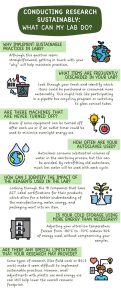Conclusions
 The mission of CVMBS is to “improve the health of animals, people, and the planet.” There are numerous research labs across CVMBS dedicated to accomplishing this mission and to making scientific discoveries and advancements that can positively impact the world at large. Unfortunately, as demonstrated throughout this guide, research labs tend to use an immense amount of resources (e.g., energy, water, animals, plastics, etc.) and generate an equally immense amount of waste (including plastic, chemical, biological, etc.). These behaviors have negative environmental and health impacts, generating waste and carbon emissions that contribute to human-driven climate change. Our research activities thus inadvertently harm the animals, people, and planet that the research within CVMBS aims to help, and this harm disproportionately impacts underrepresented communities. Therefore, the negative environmental impacts from research activities need to be acknowledged and addressed.
The mission of CVMBS is to “improve the health of animals, people, and the planet.” There are numerous research labs across CVMBS dedicated to accomplishing this mission and to making scientific discoveries and advancements that can positively impact the world at large. Unfortunately, as demonstrated throughout this guide, research labs tend to use an immense amount of resources (e.g., energy, water, animals, plastics, etc.) and generate an equally immense amount of waste (including plastic, chemical, biological, etc.). These behaviors have negative environmental and health impacts, generating waste and carbon emissions that contribute to human-driven climate change. Our research activities thus inadvertently harm the animals, people, and planet that the research within CVMBS aims to help, and this harm disproportionately impacts underrepresented communities. Therefore, the negative environmental impacts from research activities need to be acknowledged and addressed.
Fortunately, there are many available sustainable behaviors and practices that can be implemented in research labs to minimize these negative environmental impacts. This guide summarizes these behaviors and practices into twelve overarching topics along with how they can be implemented in CVMBS by building and by research area. For example, sustainable research behaviors can range from choosing more environmentally friendly reagents and minimizing single-use plastics to reusing and recycling where possible and turning off equipment and lights. While the specific behaviors and practices that can be implemented will vary among labs and while some practices may not be reasonable to implement in certain settings, it is important that labs assess their own capabilities and strive to make whatever changes they can to move toward more sustainable lab practices (see the questions below for some ideas to help you with this). Implementing sustainable practices, such as those discussed in this guide, can not only reduce resource use and waste generation and thereby mitigate negative environmental impacts but can also reduce the cost of research.
Ultimately, making research more sustainable begins with educating and empowering the individuals currently conducting research, and, importantly, instilling these practices and ideas in the younger generation of scientists. Young scientists can carry these practices and ideas into their future careers and workplaces, making sustainability more widespread and commonplace in research settings over time. Discovering and implementing sustainable research practices will continue to become more vital in order to preserve our environment and our planet. It is the responsibility of everyone conducting research to evaluate their research practices and do their part to engage in more sustainable behaviors that will positively impact the communities and environments for which research is conducted.
Authors: Kimberly Shelton, Kaitlynn Williams, and Elena Lian
Image: created with canvas.com
